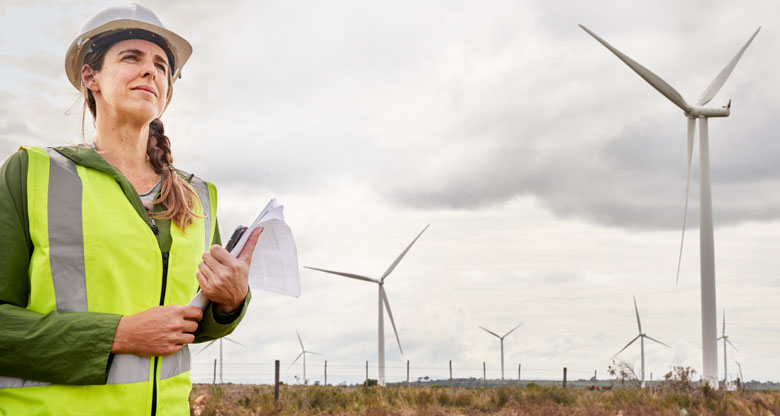Consumers and business decision-makers are factoring sustainability into their buying decisions, choosing to spend with businesses that demonstrate a strong commitment to environmental, social and governance (ESG) issues. This was a key finding from CommBank Foresight’s recent webinar, Adopting Sustainability.
“Whether you’re a retailer, wholesaler, manufacturer or property investor, you need to consider sustainability to become the business of choice,” says Jane Thomson, General Manager of Corporate Finance and ESG at CommBank. Research shows that an overwhelming majority of Australians (90%) are engaged on the topic of sustainability1, and 87% say they’re more likely to buy ethical and sustainable products2.
As a result, strong ESG practices are now essential drivers of enduring business value, Thomson says.
The four pillars of decarbonisation
Wei Sue is System Lead for Sustainable Corporates at Climateworks, an independent sustainability advisory group. She says a growing number of organisations are setting ambitious emissions reduction targets – from Wesfarmers, which aims to achieve net zero scope 1 and 2 emissions across its retail divisions by 2030, to the large super funds reducing emissions across their investment portfolios.
Climateworks modelling shows Australia can achieve net zero emissions as soon as 2035 by implementing four pillars of decarbonisation:
- Energy waste reduction – through maximising energy efficiency, as well as a shift away from energy intensive products and services.
- 100% renewable electricity – purchased from the grid or through on-site renewable generation technologies.
- Electrification of processes – a move away from fossil fuels to zero or near-zero emissions electricity or other alternatives.
- Non-energy emissions reductions – before turning to offsetting residual emissions through carbon forestry and nature-based solutions.
Sue says the pace of transition and the scale of the challenge varies significantly between sectors. “For example, the electricity and building sectors are likely to reach net zero emissions sooner, due to the technologies that are already commercially available today,” she says.
“For heavy industry businesses, key technologies are still emerging. Solutions that require further investment and development include electrification or alternative fuels such as renewable hydrogen, especially in cases where high-heat industrial processes are required.”
Agribusinesses are likely to use a combination of existing emerging technologies, along with nature-based solutions for sequestering residual emissions. “These include things like precision agriculture, resource efficiency, or regenerative practices, which could bring additional benefits in terms of cost savings or improvements to productivity,” Sue says.
The push from investors for greater sustainability
Property investment group Forza Capital has embedded sustainability into its business model and investment process, says Director Adam Murchie. “ESG is hardwired into every decision that we make as a business – we leverage ESG outcomes to reduce risk and create investment value,” he says.
Each investment is assessed through an ESG lens, with an emphasis on governance. “For us, the starting point is the G: if you get the governance right, a lot of other elements of sustainability flow on from there.”
Forza is also using technology to decarbonise its buildings. As well as more traditional forms of ESG upgrade such as solar, batteries, lighting and plant, Forza is now using remote sensors and artificial intelligence (AI) to monitor and control lighting and equipment around the clock, significantly reducing energy consumption.
“Within three weeks … we effectively paid for the installation by capturing issues after hours that would have been difficult [to detect] unless you had humans on site 24/7,” Murchie says.
Harnessing ESG to turn risks into opportunities
Murchie says that when buildings have strong sustainability credentials, it’s easier to find a tenant, purchaser or investor. That creates opportunities to transform the risks posed by obsolescent equipment into value-creation opportunities.
For example, a 100-kilowatt solar panel in Queensland costs around $150,000 to install – but can generate up to $30,000 in annual energy savings, with even greater flow-on effects for building valuations.
“So for every dollar we save, we get a 20 times uplift in terms of what someone’s willing to pay us at the back end of that investment,” Murchie says. “We have a strong belief that getting these things right will generate outperformance over the longer term.”
And Murchie is optimistic about where the market is headed, with financial institutions now pricing debt finance as a function of risk, to drive more sustainable outcomes.
“Sending price signals is the greatest opportunity I’ve ever seen in sustainability,” Murchie says. “Harnessing these shifts will fundamentally change the nature of business in the next five years.”
Key steps towards an effective ESG program
- Seek out information. “Go out there and speak to people, pick their brains, and work out which ideas you can use in your business that can shift the dial,” says Murchie.
- Get industry support. “Every industry body has an element of sustainability, so reach out to an association you’re affiliated with. The Climateworks website is a great place to start,” says Sue.
- Look for easy wins. “There are simple things like having sensor lighting, putting computers on standby when they’re not being used – if you do that across an entire organisation, the changes in energy use are significant,” says Murchie.
- Change behaviour. “Look at the behavioural elements, like whether people are driving to the office or using airline travel to get to meetings. Then see if you can incentivise people to change their behaviour,” Murchie says.
- Talk to your bank. “CommBank has a lot of resources and expertise across multiple sectors. There’s a role the bank can play in creating education and awareness,” says Sue.




